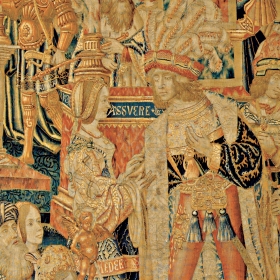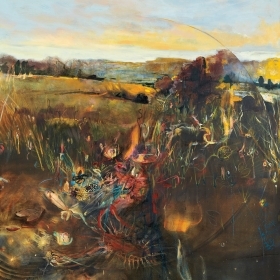The curators of the Davis Museum had long been curious about eight rare tapestries in the collection that had been resting quietly in storage for decades. Very little was known about their condition or how they had been acquired.

Everyone loves a good mystery. The curators of the Davis Museum had long been curious about eight rare tapestries in the collection that had been resting quietly in storage for decades. Very little was known about their condition or how they had been acquired. They were too large and fragile to display. Last autumn, temporary space opened up in the museum’s main gallery, enabling the curators to unroll, document, and share these tapestries with visitors.
The 16th-century Flemish tapestry shown here, dubbed “Famous Lovers,” is among the oldest and best preserved of the collection. It depicts 20 figures from Greek mythology and biblical legend, many of them grouped in pairs. At the center are Medea and Jason, dressed in the ornate robes of Flemish nobility; they’re surrounded by other couples whose relationships “ended badly, either in betrayal or death,” says curatorial assistant Alicia LaTores. These include Paris and Helen, Narcissus and Echo, and Hercules and Deianira.
We can only wonder if the artist’s choice of subject—doomed couples—was meant to tell us something about the folly of love. LaTores says the tapestry may have carried a superscription that explained its theme, but the top part of the textile may have been cut off. (Tapestries were often resized by their owners and given new borders.)
“It seems like a complete piece, but if you look closely, you wonder what else was on it,” she says. “We’ve lost a lot of the meaning over time.”
What has not been lost are the vivid colors and richly textured weaving. This piece was made at the height of tapestry production in mid-1500s Brussels, which was a center for the wool trade. To make a tapestry, an artist in a Brussels workshop first painted the image to be depicted and then a “cartoon” was made that enabled master weavers to translate the design to the loom.
Aristocratic families commissioned tapestries to trumpet their wealth as well as to block the cold in their drafty castles. They rotated tapestries based on the season and to mark special occasions. You can imagine the “Famous Lovers” tapestry occupying pride of place in a royal anteroom or being given as a wedding present. No one can say where it hung all those centuries before it was purchased by benefactor Galen Stone and his wife as a gift to the College. But then, imagining its colorful history is half the fun.

Tapestry (“Famous Lovers”) Unknown (Flemish), 16th century, Wool and silk weft on wool warp with linen backing, 169¾ in. x 105 in. Gift of Mr. and Mrs. Galen L. Stone, 1924.

